NURS2003: Pathophysiology and Pharmacology Exploration in Colon Cancer
VerifiedAdded on 2023/04/24
|9
|2672
|254
Case Study
AI Summary
This case study delves into the pathophysiology and pharmacology related to Mrs. Margaret “Margie” Smith, a 79-year-old woman diagnosed with colon cancer. The analysis identifies three key symptoms: rectal bleeding, irregular bowel movement, and unintentional weight loss, detailing their underlying pathophysiology in the context of colon cancer. The discussion extends to the medical interventions employed, specifically metronidazole, cephalothin, and clopidogrel, elucidating their respective pharmacological actions and relevance to the patient's treatment plan, including pre-surgical preparation and infection prevention. The study provides a comprehensive overview of the disease's progression and the rationale behind the chosen medical interventions, offering valuable insights into the management of colon cancer.
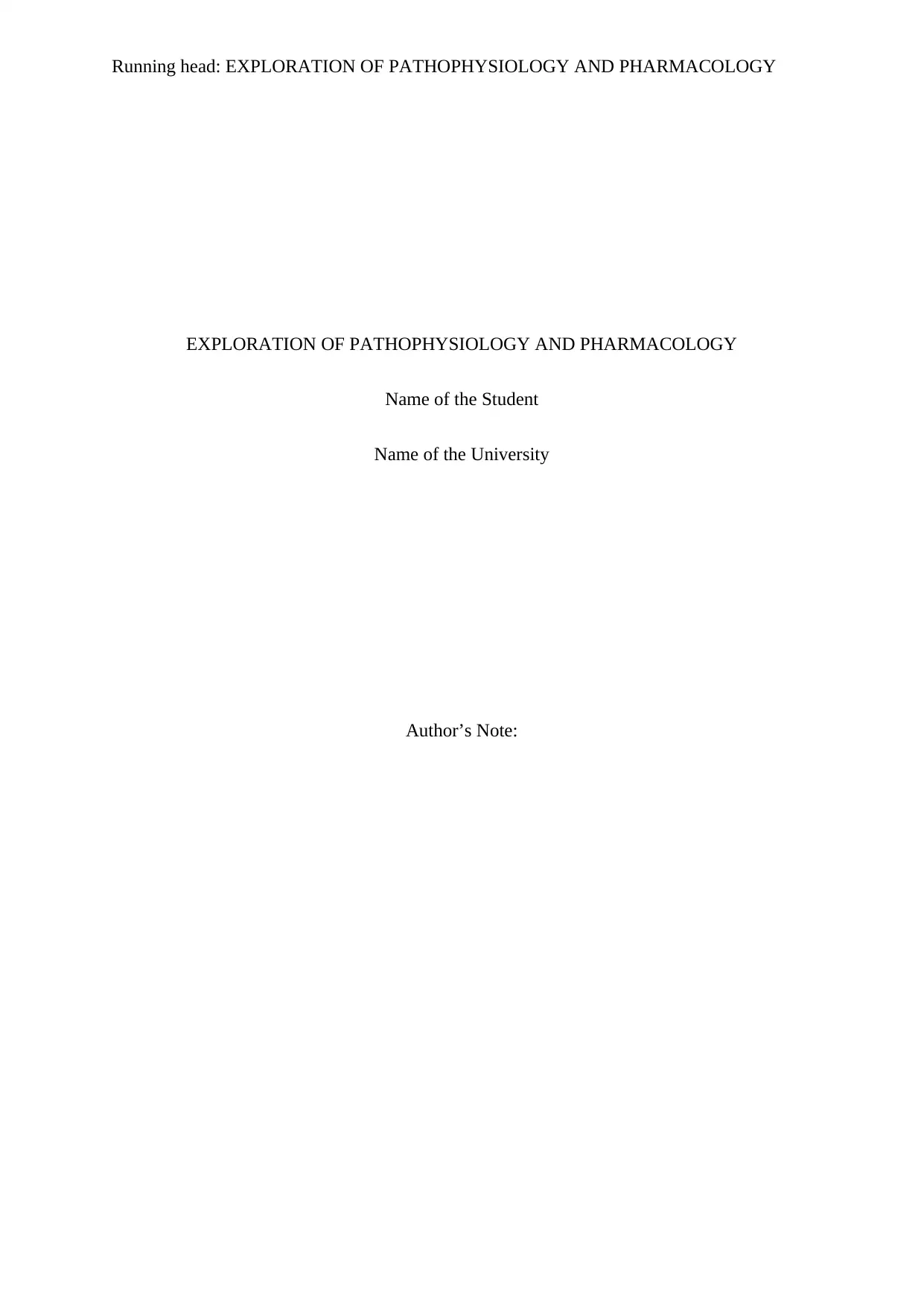
Running head: EXPLORATION OF PATHOPHYSIOLOGY AND PHARMACOLOGY
EXPLORATION OF PATHOPHYSIOLOGY AND PHARMACOLOGY
Name of the Student
Name of the University
Author’s Note:
EXPLORATION OF PATHOPHYSIOLOGY AND PHARMACOLOGY
Name of the Student
Name of the University
Author’s Note:
Paraphrase This Document
Need a fresh take? Get an instant paraphrase of this document with our AI Paraphraser
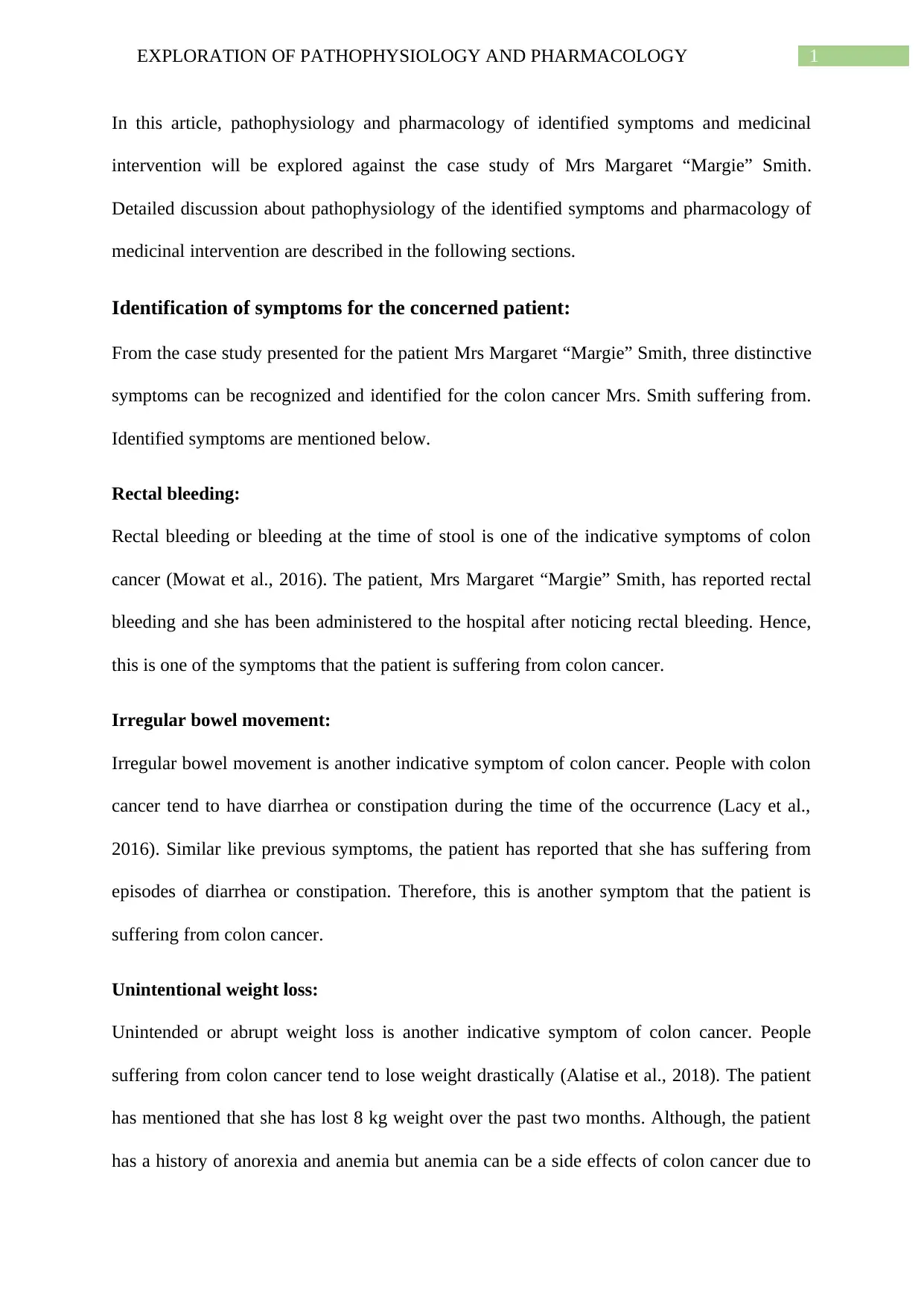
1EXPLORATION OF PATHOPHYSIOLOGY AND PHARMACOLOGY
In this article, pathophysiology and pharmacology of identified symptoms and medicinal
intervention will be explored against the case study of Mrs Margaret “Margie” Smith.
Detailed discussion about pathophysiology of the identified symptoms and pharmacology of
medicinal intervention are described in the following sections.
Identification of symptoms for the concerned patient:
From the case study presented for the patient Mrs Margaret “Margie” Smith, three distinctive
symptoms can be recognized and identified for the colon cancer Mrs. Smith suffering from.
Identified symptoms are mentioned below.
Rectal bleeding:
Rectal bleeding or bleeding at the time of stool is one of the indicative symptoms of colon
cancer (Mowat et al., 2016). The patient, Mrs Margaret “Margie” Smith, has reported rectal
bleeding and she has been administered to the hospital after noticing rectal bleeding. Hence,
this is one of the symptoms that the patient is suffering from colon cancer.
Irregular bowel movement:
Irregular bowel movement is another indicative symptom of colon cancer. People with colon
cancer tend to have diarrhea or constipation during the time of the occurrence (Lacy et al.,
2016). Similar like previous symptoms, the patient has reported that she has suffering from
episodes of diarrhea or constipation. Therefore, this is another symptom that the patient is
suffering from colon cancer.
Unintentional weight loss:
Unintended or abrupt weight loss is another indicative symptom of colon cancer. People
suffering from colon cancer tend to lose weight drastically (Alatise et al., 2018). The patient
has mentioned that she has lost 8 kg weight over the past two months. Although, the patient
has a history of anorexia and anemia but anemia can be a side effects of colon cancer due to
In this article, pathophysiology and pharmacology of identified symptoms and medicinal
intervention will be explored against the case study of Mrs Margaret “Margie” Smith.
Detailed discussion about pathophysiology of the identified symptoms and pharmacology of
medicinal intervention are described in the following sections.
Identification of symptoms for the concerned patient:
From the case study presented for the patient Mrs Margaret “Margie” Smith, three distinctive
symptoms can be recognized and identified for the colon cancer Mrs. Smith suffering from.
Identified symptoms are mentioned below.
Rectal bleeding:
Rectal bleeding or bleeding at the time of stool is one of the indicative symptoms of colon
cancer (Mowat et al., 2016). The patient, Mrs Margaret “Margie” Smith, has reported rectal
bleeding and she has been administered to the hospital after noticing rectal bleeding. Hence,
this is one of the symptoms that the patient is suffering from colon cancer.
Irregular bowel movement:
Irregular bowel movement is another indicative symptom of colon cancer. People with colon
cancer tend to have diarrhea or constipation during the time of the occurrence (Lacy et al.,
2016). Similar like previous symptoms, the patient has reported that she has suffering from
episodes of diarrhea or constipation. Therefore, this is another symptom that the patient is
suffering from colon cancer.
Unintentional weight loss:
Unintended or abrupt weight loss is another indicative symptom of colon cancer. People
suffering from colon cancer tend to lose weight drastically (Alatise et al., 2018). The patient
has mentioned that she has lost 8 kg weight over the past two months. Although, the patient
has a history of anorexia and anemia but anemia can be a side effects of colon cancer due to
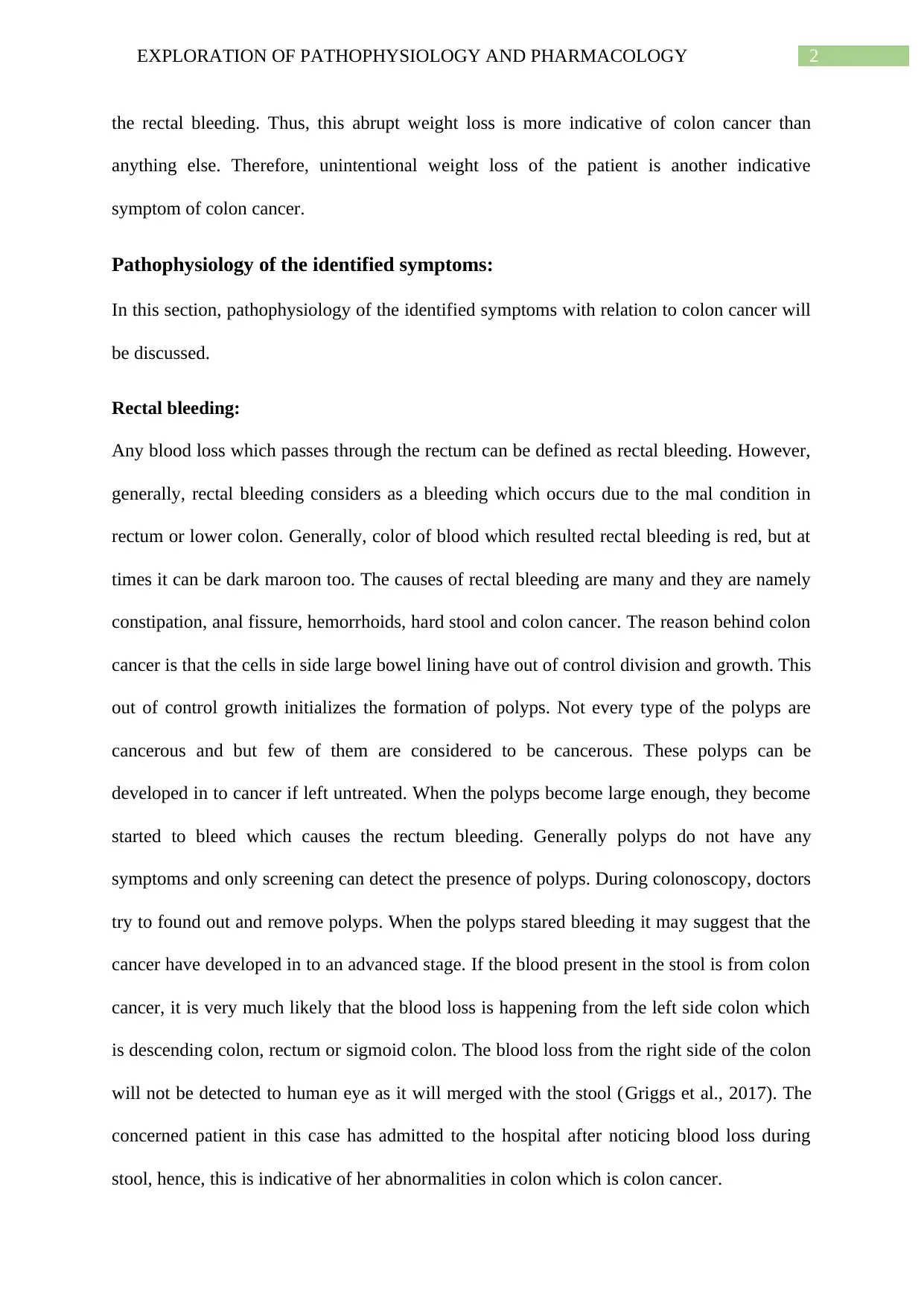
2EXPLORATION OF PATHOPHYSIOLOGY AND PHARMACOLOGY
the rectal bleeding. Thus, this abrupt weight loss is more indicative of colon cancer than
anything else. Therefore, unintentional weight loss of the patient is another indicative
symptom of colon cancer.
Pathophysiology of the identified symptoms:
In this section, pathophysiology of the identified symptoms with relation to colon cancer will
be discussed.
Rectal bleeding:
Any blood loss which passes through the rectum can be defined as rectal bleeding. However,
generally, rectal bleeding considers as a bleeding which occurs due to the mal condition in
rectum or lower colon. Generally, color of blood which resulted rectal bleeding is red, but at
times it can be dark maroon too. The causes of rectal bleeding are many and they are namely
constipation, anal fissure, hemorrhoids, hard stool and colon cancer. The reason behind colon
cancer is that the cells in side large bowel lining have out of control division and growth. This
out of control growth initializes the formation of polyps. Not every type of the polyps are
cancerous and but few of them are considered to be cancerous. These polyps can be
developed in to cancer if left untreated. When the polyps become large enough, they become
started to bleed which causes the rectum bleeding. Generally polyps do not have any
symptoms and only screening can detect the presence of polyps. During colonoscopy, doctors
try to found out and remove polyps. When the polyps stared bleeding it may suggest that the
cancer have developed in to an advanced stage. If the blood present in the stool is from colon
cancer, it is very much likely that the blood loss is happening from the left side colon which
is descending colon, rectum or sigmoid colon. The blood loss from the right side of the colon
will not be detected to human eye as it will merged with the stool (Griggs et al., 2017). The
concerned patient in this case has admitted to the hospital after noticing blood loss during
stool, hence, this is indicative of her abnormalities in colon which is colon cancer.
the rectal bleeding. Thus, this abrupt weight loss is more indicative of colon cancer than
anything else. Therefore, unintentional weight loss of the patient is another indicative
symptom of colon cancer.
Pathophysiology of the identified symptoms:
In this section, pathophysiology of the identified symptoms with relation to colon cancer will
be discussed.
Rectal bleeding:
Any blood loss which passes through the rectum can be defined as rectal bleeding. However,
generally, rectal bleeding considers as a bleeding which occurs due to the mal condition in
rectum or lower colon. Generally, color of blood which resulted rectal bleeding is red, but at
times it can be dark maroon too. The causes of rectal bleeding are many and they are namely
constipation, anal fissure, hemorrhoids, hard stool and colon cancer. The reason behind colon
cancer is that the cells in side large bowel lining have out of control division and growth. This
out of control growth initializes the formation of polyps. Not every type of the polyps are
cancerous and but few of them are considered to be cancerous. These polyps can be
developed in to cancer if left untreated. When the polyps become large enough, they become
started to bleed which causes the rectum bleeding. Generally polyps do not have any
symptoms and only screening can detect the presence of polyps. During colonoscopy, doctors
try to found out and remove polyps. When the polyps stared bleeding it may suggest that the
cancer have developed in to an advanced stage. If the blood present in the stool is from colon
cancer, it is very much likely that the blood loss is happening from the left side colon which
is descending colon, rectum or sigmoid colon. The blood loss from the right side of the colon
will not be detected to human eye as it will merged with the stool (Griggs et al., 2017). The
concerned patient in this case has admitted to the hospital after noticing blood loss during
stool, hence, this is indicative of her abnormalities in colon which is colon cancer.
⊘ This is a preview!⊘
Do you want full access?
Subscribe today to unlock all pages.

Trusted by 1+ million students worldwide
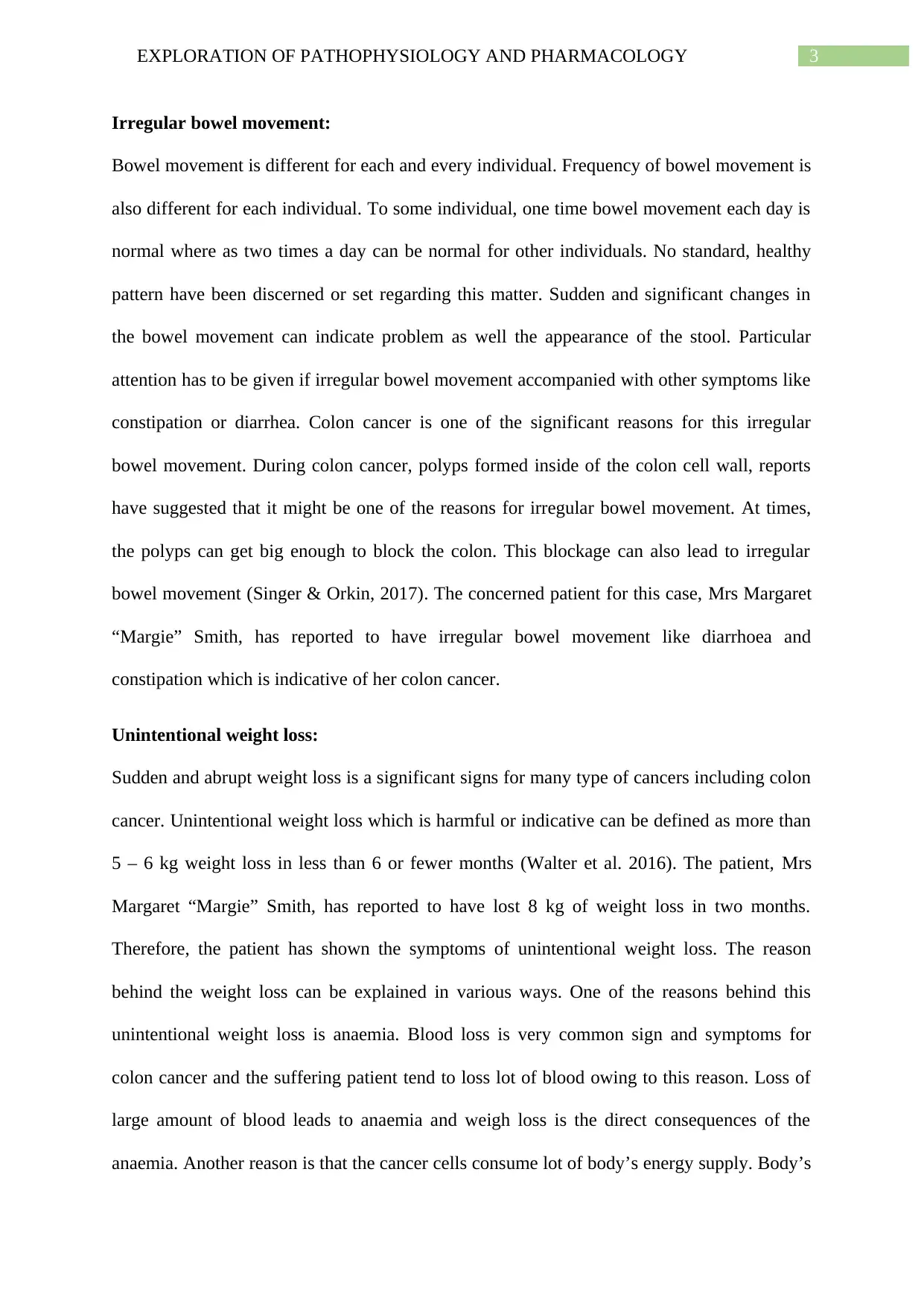
3EXPLORATION OF PATHOPHYSIOLOGY AND PHARMACOLOGY
Irregular bowel movement:
Bowel movement is different for each and every individual. Frequency of bowel movement is
also different for each individual. To some individual, one time bowel movement each day is
normal where as two times a day can be normal for other individuals. No standard, healthy
pattern have been discerned or set regarding this matter. Sudden and significant changes in
the bowel movement can indicate problem as well the appearance of the stool. Particular
attention has to be given if irregular bowel movement accompanied with other symptoms like
constipation or diarrhea. Colon cancer is one of the significant reasons for this irregular
bowel movement. During colon cancer, polyps formed inside of the colon cell wall, reports
have suggested that it might be one of the reasons for irregular bowel movement. At times,
the polyps can get big enough to block the colon. This blockage can also lead to irregular
bowel movement (Singer & Orkin, 2017). The concerned patient for this case, Mrs Margaret
“Margie” Smith, has reported to have irregular bowel movement like diarrhoea and
constipation which is indicative of her colon cancer.
Unintentional weight loss:
Sudden and abrupt weight loss is a significant signs for many type of cancers including colon
cancer. Unintentional weight loss which is harmful or indicative can be defined as more than
5 – 6 kg weight loss in less than 6 or fewer months (Walter et al. 2016). The patient, Mrs
Margaret “Margie” Smith, has reported to have lost 8 kg of weight loss in two months.
Therefore, the patient has shown the symptoms of unintentional weight loss. The reason
behind the weight loss can be explained in various ways. One of the reasons behind this
unintentional weight loss is anaemia. Blood loss is very common sign and symptoms for
colon cancer and the suffering patient tend to loss lot of blood owing to this reason. Loss of
large amount of blood leads to anaemia and weigh loss is the direct consequences of the
anaemia. Another reason is that the cancer cells consume lot of body’s energy supply. Body’s
Irregular bowel movement:
Bowel movement is different for each and every individual. Frequency of bowel movement is
also different for each individual. To some individual, one time bowel movement each day is
normal where as two times a day can be normal for other individuals. No standard, healthy
pattern have been discerned or set regarding this matter. Sudden and significant changes in
the bowel movement can indicate problem as well the appearance of the stool. Particular
attention has to be given if irregular bowel movement accompanied with other symptoms like
constipation or diarrhea. Colon cancer is one of the significant reasons for this irregular
bowel movement. During colon cancer, polyps formed inside of the colon cell wall, reports
have suggested that it might be one of the reasons for irregular bowel movement. At times,
the polyps can get big enough to block the colon. This blockage can also lead to irregular
bowel movement (Singer & Orkin, 2017). The concerned patient for this case, Mrs Margaret
“Margie” Smith, has reported to have irregular bowel movement like diarrhoea and
constipation which is indicative of her colon cancer.
Unintentional weight loss:
Sudden and abrupt weight loss is a significant signs for many type of cancers including colon
cancer. Unintentional weight loss which is harmful or indicative can be defined as more than
5 – 6 kg weight loss in less than 6 or fewer months (Walter et al. 2016). The patient, Mrs
Margaret “Margie” Smith, has reported to have lost 8 kg of weight loss in two months.
Therefore, the patient has shown the symptoms of unintentional weight loss. The reason
behind the weight loss can be explained in various ways. One of the reasons behind this
unintentional weight loss is anaemia. Blood loss is very common sign and symptoms for
colon cancer and the suffering patient tend to loss lot of blood owing to this reason. Loss of
large amount of blood leads to anaemia and weigh loss is the direct consequences of the
anaemia. Another reason is that the cancer cells consume lot of body’s energy supply. Body’s
Paraphrase This Document
Need a fresh take? Get an instant paraphrase of this document with our AI Paraphraser
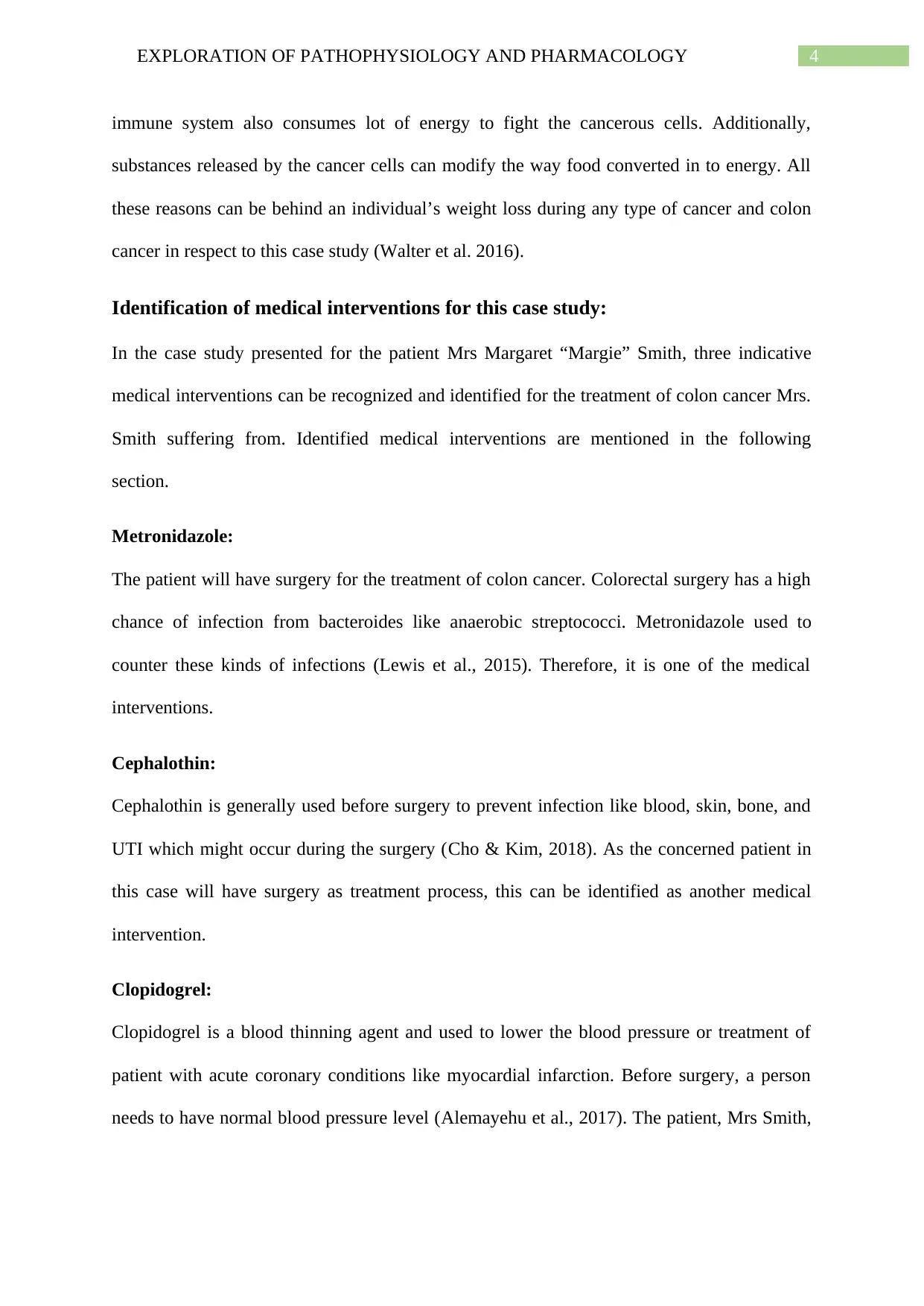
4EXPLORATION OF PATHOPHYSIOLOGY AND PHARMACOLOGY
immune system also consumes lot of energy to fight the cancerous cells. Additionally,
substances released by the cancer cells can modify the way food converted in to energy. All
these reasons can be behind an individual’s weight loss during any type of cancer and colon
cancer in respect to this case study (Walter et al. 2016).
Identification of medical interventions for this case study:
In the case study presented for the patient Mrs Margaret “Margie” Smith, three indicative
medical interventions can be recognized and identified for the treatment of colon cancer Mrs.
Smith suffering from. Identified medical interventions are mentioned in the following
section.
Metronidazole:
The patient will have surgery for the treatment of colon cancer. Colorectal surgery has a high
chance of infection from bacteroides like anaerobic streptococci. Metronidazole used to
counter these kinds of infections (Lewis et al., 2015). Therefore, it is one of the medical
interventions.
Cephalothin:
Cephalothin is generally used before surgery to prevent infection like blood, skin, bone, and
UTI which might occur during the surgery (Cho & Kim, 2018). As the concerned patient in
this case will have surgery as treatment process, this can be identified as another medical
intervention.
Clopidogrel:
Clopidogrel is a blood thinning agent and used to lower the blood pressure or treatment of
patient with acute coronary conditions like myocardial infarction. Before surgery, a person
needs to have normal blood pressure level (Alemayehu et al., 2017). The patient, Mrs Smith,
immune system also consumes lot of energy to fight the cancerous cells. Additionally,
substances released by the cancer cells can modify the way food converted in to energy. All
these reasons can be behind an individual’s weight loss during any type of cancer and colon
cancer in respect to this case study (Walter et al. 2016).
Identification of medical interventions for this case study:
In the case study presented for the patient Mrs Margaret “Margie” Smith, three indicative
medical interventions can be recognized and identified for the treatment of colon cancer Mrs.
Smith suffering from. Identified medical interventions are mentioned in the following
section.
Metronidazole:
The patient will have surgery for the treatment of colon cancer. Colorectal surgery has a high
chance of infection from bacteroides like anaerobic streptococci. Metronidazole used to
counter these kinds of infections (Lewis et al., 2015). Therefore, it is one of the medical
interventions.
Cephalothin:
Cephalothin is generally used before surgery to prevent infection like blood, skin, bone, and
UTI which might occur during the surgery (Cho & Kim, 2018). As the concerned patient in
this case will have surgery as treatment process, this can be identified as another medical
intervention.
Clopidogrel:
Clopidogrel is a blood thinning agent and used to lower the blood pressure or treatment of
patient with acute coronary conditions like myocardial infarction. Before surgery, a person
needs to have normal blood pressure level (Alemayehu et al., 2017). The patient, Mrs Smith,
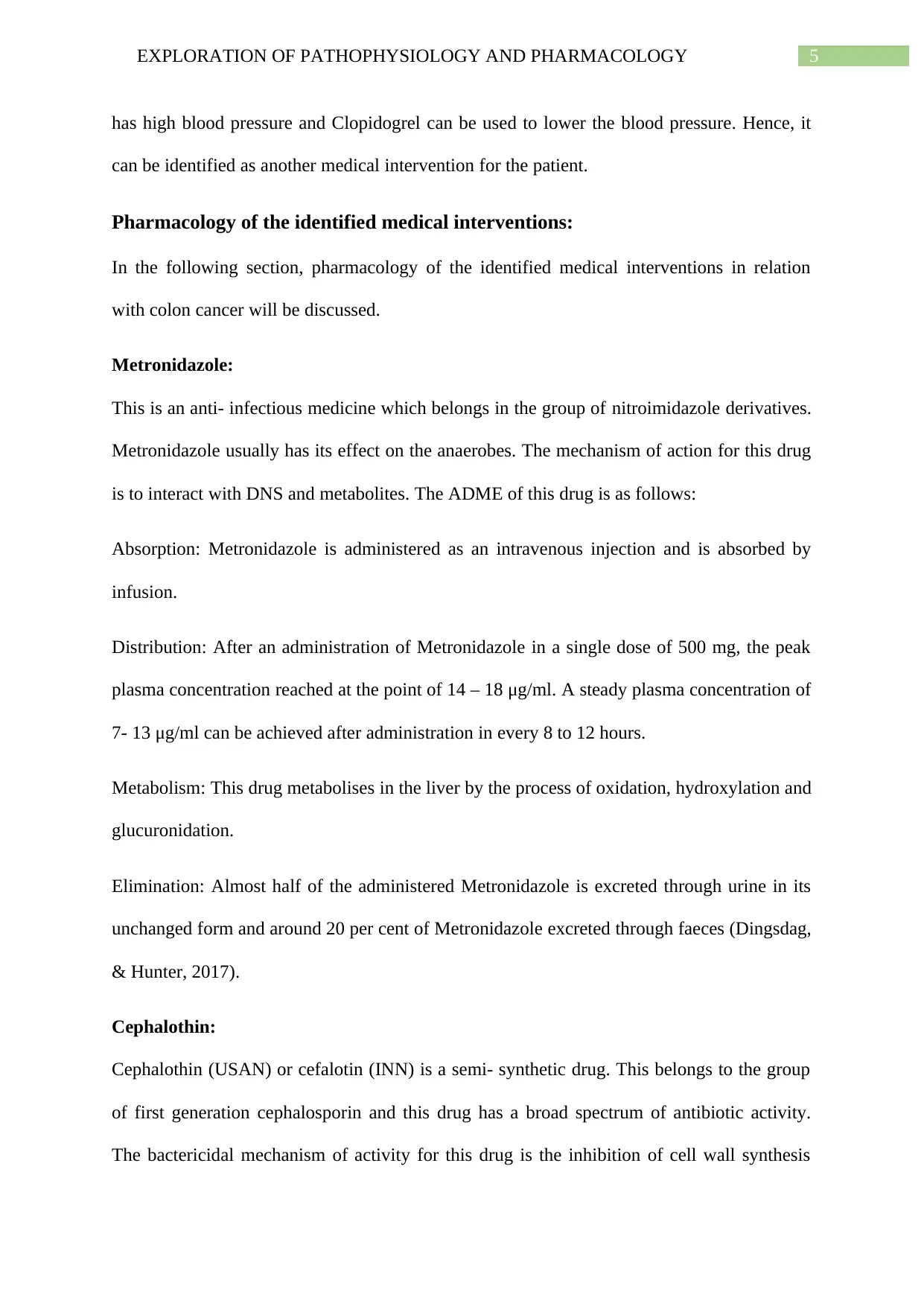
5EXPLORATION OF PATHOPHYSIOLOGY AND PHARMACOLOGY
has high blood pressure and Clopidogrel can be used to lower the blood pressure. Hence, it
can be identified as another medical intervention for the patient.
Pharmacology of the identified medical interventions:
In the following section, pharmacology of the identified medical interventions in relation
with colon cancer will be discussed.
Metronidazole:
This is an anti- infectious medicine which belongs in the group of nitroimidazole derivatives.
Metronidazole usually has its effect on the anaerobes. The mechanism of action for this drug
is to interact with DNS and metabolites. The ADME of this drug is as follows:
Absorption: Metronidazole is administered as an intravenous injection and is absorbed by
infusion.
Distribution: After an administration of Metronidazole in a single dose of 500 mg, the peak
plasma concentration reached at the point of 14 – 18 μg/ml. A steady plasma concentration of
7- 13 μg/ml can be achieved after administration in every 8 to 12 hours.
Metabolism: This drug metabolises in the liver by the process of oxidation, hydroxylation and
glucuronidation.
Elimination: Almost half of the administered Metronidazole is excreted through urine in its
unchanged form and around 20 per cent of Metronidazole excreted through faeces (Dingsdag,
& Hunter, 2017).
Cephalothin:
Cephalothin (USAN) or cefalotin (INN) is a semi- synthetic drug. This belongs to the group
of first generation cephalosporin and this drug has a broad spectrum of antibiotic activity.
The bactericidal mechanism of activity for this drug is the inhibition of cell wall synthesis
has high blood pressure and Clopidogrel can be used to lower the blood pressure. Hence, it
can be identified as another medical intervention for the patient.
Pharmacology of the identified medical interventions:
In the following section, pharmacology of the identified medical interventions in relation
with colon cancer will be discussed.
Metronidazole:
This is an anti- infectious medicine which belongs in the group of nitroimidazole derivatives.
Metronidazole usually has its effect on the anaerobes. The mechanism of action for this drug
is to interact with DNS and metabolites. The ADME of this drug is as follows:
Absorption: Metronidazole is administered as an intravenous injection and is absorbed by
infusion.
Distribution: After an administration of Metronidazole in a single dose of 500 mg, the peak
plasma concentration reached at the point of 14 – 18 μg/ml. A steady plasma concentration of
7- 13 μg/ml can be achieved after administration in every 8 to 12 hours.
Metabolism: This drug metabolises in the liver by the process of oxidation, hydroxylation and
glucuronidation.
Elimination: Almost half of the administered Metronidazole is excreted through urine in its
unchanged form and around 20 per cent of Metronidazole excreted through faeces (Dingsdag,
& Hunter, 2017).
Cephalothin:
Cephalothin (USAN) or cefalotin (INN) is a semi- synthetic drug. This belongs to the group
of first generation cephalosporin and this drug has a broad spectrum of antibiotic activity.
The bactericidal mechanism of activity for this drug is the inhibition of cell wall synthesis
⊘ This is a preview!⊘
Do you want full access?
Subscribe today to unlock all pages.

Trusted by 1+ million students worldwide
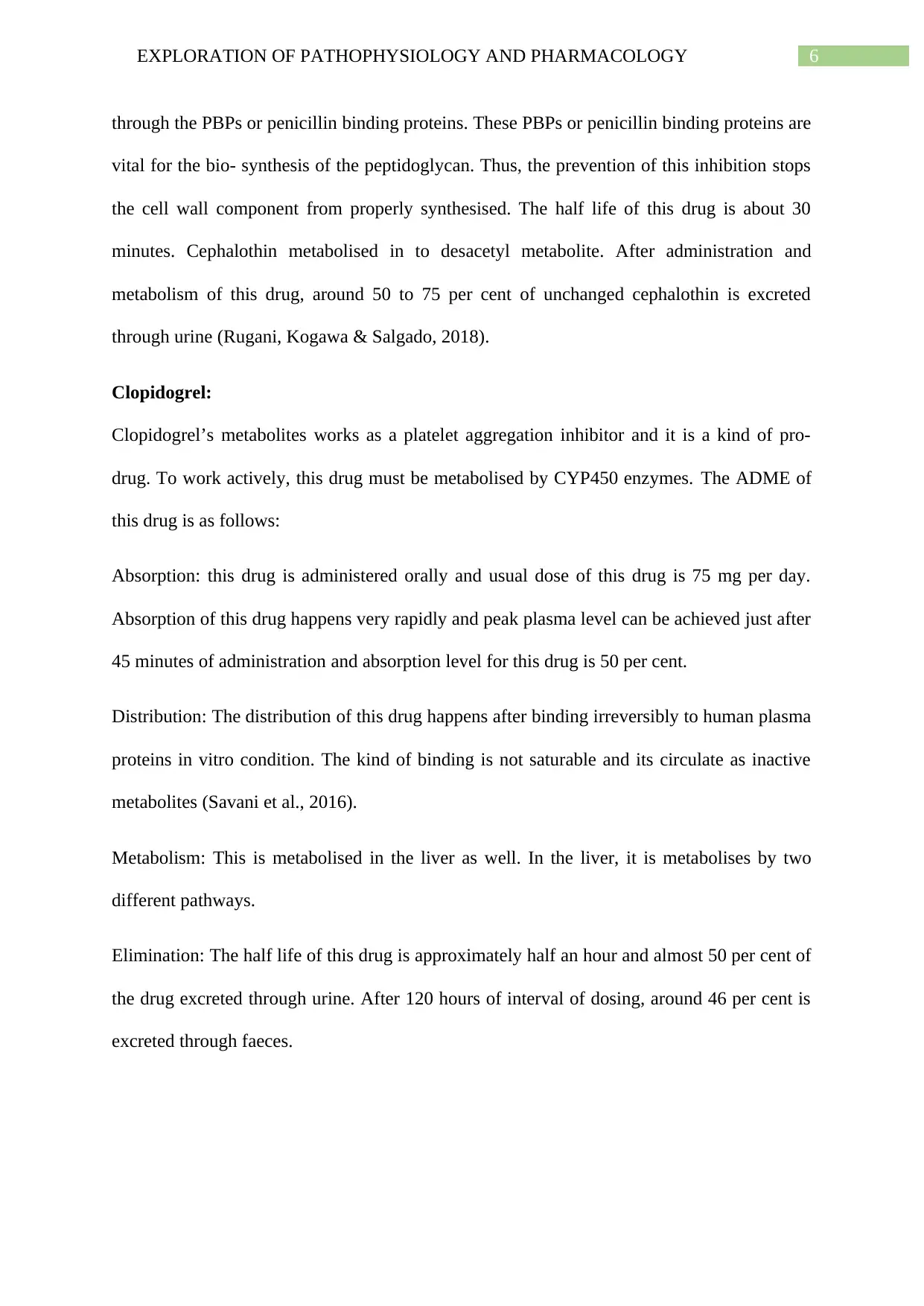
6EXPLORATION OF PATHOPHYSIOLOGY AND PHARMACOLOGY
through the PBPs or penicillin binding proteins. These PBPs or penicillin binding proteins are
vital for the bio- synthesis of the peptidoglycan. Thus, the prevention of this inhibition stops
the cell wall component from properly synthesised. The half life of this drug is about 30
minutes. Cephalothin metabolised in to desacetyl metabolite. After administration and
metabolism of this drug, around 50 to 75 per cent of unchanged cephalothin is excreted
through urine (Rugani, Kogawa & Salgado, 2018).
Clopidogrel:
Clopidogrel’s metabolites works as a platelet aggregation inhibitor and it is a kind of pro-
drug. To work actively, this drug must be metabolised by CYP450 enzymes. The ADME of
this drug is as follows:
Absorption: this drug is administered orally and usual dose of this drug is 75 mg per day.
Absorption of this drug happens very rapidly and peak plasma level can be achieved just after
45 minutes of administration and absorption level for this drug is 50 per cent.
Distribution: The distribution of this drug happens after binding irreversibly to human plasma
proteins in vitro condition. The kind of binding is not saturable and its circulate as inactive
metabolites (Savani et al., 2016).
Metabolism: This is metabolised in the liver as well. In the liver, it is metabolises by two
different pathways.
Elimination: The half life of this drug is approximately half an hour and almost 50 per cent of
the drug excreted through urine. After 120 hours of interval of dosing, around 46 per cent is
excreted through faeces.
through the PBPs or penicillin binding proteins. These PBPs or penicillin binding proteins are
vital for the bio- synthesis of the peptidoglycan. Thus, the prevention of this inhibition stops
the cell wall component from properly synthesised. The half life of this drug is about 30
minutes. Cephalothin metabolised in to desacetyl metabolite. After administration and
metabolism of this drug, around 50 to 75 per cent of unchanged cephalothin is excreted
through urine (Rugani, Kogawa & Salgado, 2018).
Clopidogrel:
Clopidogrel’s metabolites works as a platelet aggregation inhibitor and it is a kind of pro-
drug. To work actively, this drug must be metabolised by CYP450 enzymes. The ADME of
this drug is as follows:
Absorption: this drug is administered orally and usual dose of this drug is 75 mg per day.
Absorption of this drug happens very rapidly and peak plasma level can be achieved just after
45 minutes of administration and absorption level for this drug is 50 per cent.
Distribution: The distribution of this drug happens after binding irreversibly to human plasma
proteins in vitro condition. The kind of binding is not saturable and its circulate as inactive
metabolites (Savani et al., 2016).
Metabolism: This is metabolised in the liver as well. In the liver, it is metabolises by two
different pathways.
Elimination: The half life of this drug is approximately half an hour and almost 50 per cent of
the drug excreted through urine. After 120 hours of interval of dosing, around 46 per cent is
excreted through faeces.
Paraphrase This Document
Need a fresh take? Get an instant paraphrase of this document with our AI Paraphraser
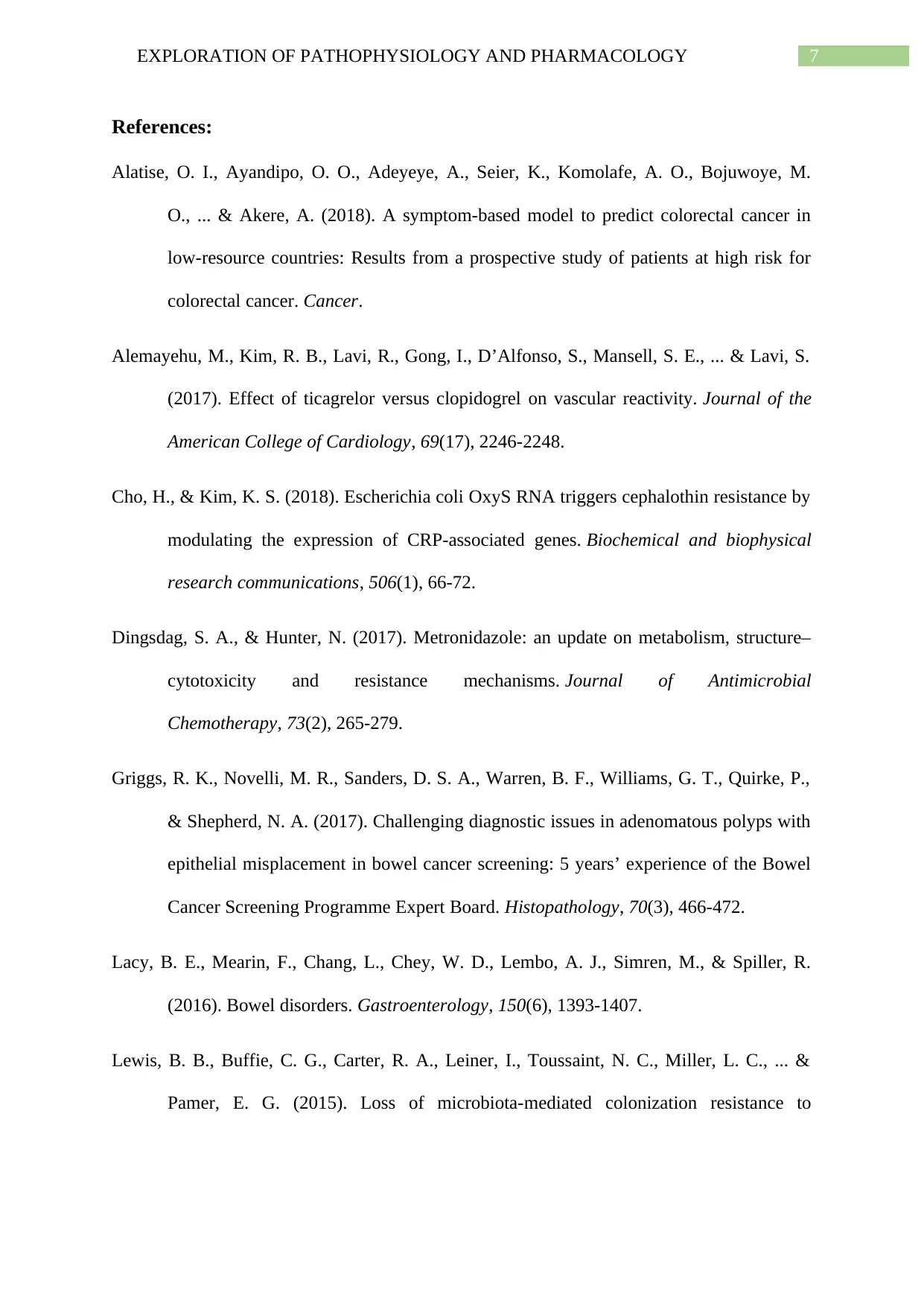
7EXPLORATION OF PATHOPHYSIOLOGY AND PHARMACOLOGY
References:
Alatise, O. I., Ayandipo, O. O., Adeyeye, A., Seier, K., Komolafe, A. O., Bojuwoye, M.
O., ... & Akere, A. (2018). A symptom‐based model to predict colorectal cancer in
low‐resource countries: Results from a prospective study of patients at high risk for
colorectal cancer. Cancer.
Alemayehu, M., Kim, R. B., Lavi, R., Gong, I., D’Alfonso, S., Mansell, S. E., ... & Lavi, S.
(2017). Effect of ticagrelor versus clopidogrel on vascular reactivity. Journal of the
American College of Cardiology, 69(17), 2246-2248.
Cho, H., & Kim, K. S. (2018). Escherichia coli OxyS RNA triggers cephalothin resistance by
modulating the expression of CRP-associated genes. Biochemical and biophysical
research communications, 506(1), 66-72.
Dingsdag, S. A., & Hunter, N. (2017). Metronidazole: an update on metabolism, structure–
cytotoxicity and resistance mechanisms. Journal of Antimicrobial
Chemotherapy, 73(2), 265-279.
Griggs, R. K., Novelli, M. R., Sanders, D. S. A., Warren, B. F., Williams, G. T., Quirke, P.,
& Shepherd, N. A. (2017). Challenging diagnostic issues in adenomatous polyps with
epithelial misplacement in bowel cancer screening: 5 years’ experience of the Bowel
Cancer Screening Programme Expert Board. Histopathology, 70(3), 466-472.
Lacy, B. E., Mearin, F., Chang, L., Chey, W. D., Lembo, A. J., Simren, M., & Spiller, R.
(2016). Bowel disorders. Gastroenterology, 150(6), 1393-1407.
Lewis, B. B., Buffie, C. G., Carter, R. A., Leiner, I., Toussaint, N. C., Miller, L. C., ... &
Pamer, E. G. (2015). Loss of microbiota-mediated colonization resistance to
References:
Alatise, O. I., Ayandipo, O. O., Adeyeye, A., Seier, K., Komolafe, A. O., Bojuwoye, M.
O., ... & Akere, A. (2018). A symptom‐based model to predict colorectal cancer in
low‐resource countries: Results from a prospective study of patients at high risk for
colorectal cancer. Cancer.
Alemayehu, M., Kim, R. B., Lavi, R., Gong, I., D’Alfonso, S., Mansell, S. E., ... & Lavi, S.
(2017). Effect of ticagrelor versus clopidogrel on vascular reactivity. Journal of the
American College of Cardiology, 69(17), 2246-2248.
Cho, H., & Kim, K. S. (2018). Escherichia coli OxyS RNA triggers cephalothin resistance by
modulating the expression of CRP-associated genes. Biochemical and biophysical
research communications, 506(1), 66-72.
Dingsdag, S. A., & Hunter, N. (2017). Metronidazole: an update on metabolism, structure–
cytotoxicity and resistance mechanisms. Journal of Antimicrobial
Chemotherapy, 73(2), 265-279.
Griggs, R. K., Novelli, M. R., Sanders, D. S. A., Warren, B. F., Williams, G. T., Quirke, P.,
& Shepherd, N. A. (2017). Challenging diagnostic issues in adenomatous polyps with
epithelial misplacement in bowel cancer screening: 5 years’ experience of the Bowel
Cancer Screening Programme Expert Board. Histopathology, 70(3), 466-472.
Lacy, B. E., Mearin, F., Chang, L., Chey, W. D., Lembo, A. J., Simren, M., & Spiller, R.
(2016). Bowel disorders. Gastroenterology, 150(6), 1393-1407.
Lewis, B. B., Buffie, C. G., Carter, R. A., Leiner, I., Toussaint, N. C., Miller, L. C., ... &
Pamer, E. G. (2015). Loss of microbiota-mediated colonization resistance to
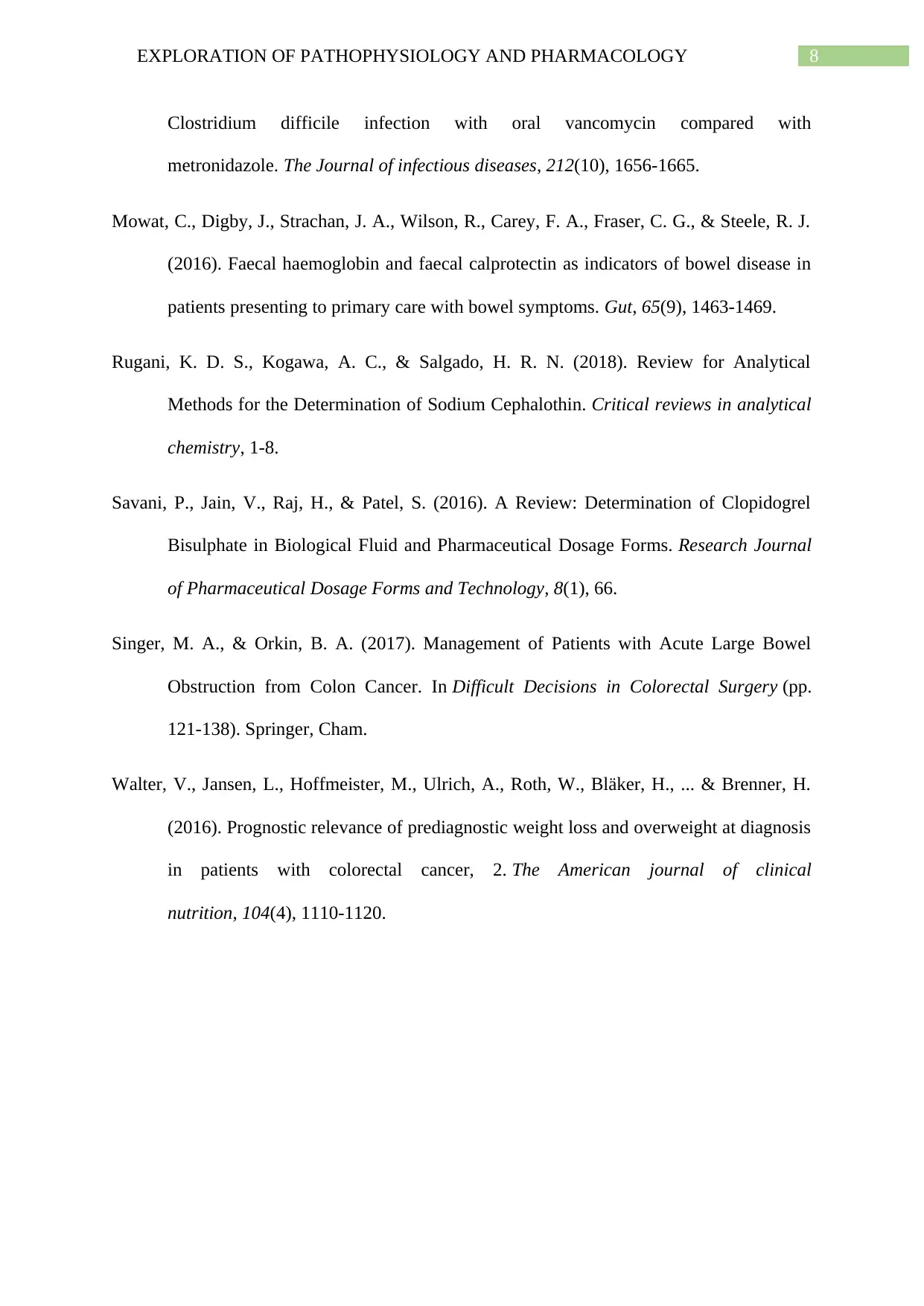
8EXPLORATION OF PATHOPHYSIOLOGY AND PHARMACOLOGY
Clostridium difficile infection with oral vancomycin compared with
metronidazole. The Journal of infectious diseases, 212(10), 1656-1665.
Mowat, C., Digby, J., Strachan, J. A., Wilson, R., Carey, F. A., Fraser, C. G., & Steele, R. J.
(2016). Faecal haemoglobin and faecal calprotectin as indicators of bowel disease in
patients presenting to primary care with bowel symptoms. Gut, 65(9), 1463-1469.
Rugani, K. D. S., Kogawa, A. C., & Salgado, H. R. N. (2018). Review for Analytical
Methods for the Determination of Sodium Cephalothin. Critical reviews in analytical
chemistry, 1-8.
Savani, P., Jain, V., Raj, H., & Patel, S. (2016). A Review: Determination of Clopidogrel
Bisulphate in Biological Fluid and Pharmaceutical Dosage Forms. Research Journal
of Pharmaceutical Dosage Forms and Technology, 8(1), 66.
Singer, M. A., & Orkin, B. A. (2017). Management of Patients with Acute Large Bowel
Obstruction from Colon Cancer. In Difficult Decisions in Colorectal Surgery (pp.
121-138). Springer, Cham.
Walter, V., Jansen, L., Hoffmeister, M., Ulrich, A., Roth, W., Bläker, H., ... & Brenner, H.
(2016). Prognostic relevance of prediagnostic weight loss and overweight at diagnosis
in patients with colorectal cancer, 2. The American journal of clinical
nutrition, 104(4), 1110-1120.
Clostridium difficile infection with oral vancomycin compared with
metronidazole. The Journal of infectious diseases, 212(10), 1656-1665.
Mowat, C., Digby, J., Strachan, J. A., Wilson, R., Carey, F. A., Fraser, C. G., & Steele, R. J.
(2016). Faecal haemoglobin and faecal calprotectin as indicators of bowel disease in
patients presenting to primary care with bowel symptoms. Gut, 65(9), 1463-1469.
Rugani, K. D. S., Kogawa, A. C., & Salgado, H. R. N. (2018). Review for Analytical
Methods for the Determination of Sodium Cephalothin. Critical reviews in analytical
chemistry, 1-8.
Savani, P., Jain, V., Raj, H., & Patel, S. (2016). A Review: Determination of Clopidogrel
Bisulphate in Biological Fluid and Pharmaceutical Dosage Forms. Research Journal
of Pharmaceutical Dosage Forms and Technology, 8(1), 66.
Singer, M. A., & Orkin, B. A. (2017). Management of Patients with Acute Large Bowel
Obstruction from Colon Cancer. In Difficult Decisions in Colorectal Surgery (pp.
121-138). Springer, Cham.
Walter, V., Jansen, L., Hoffmeister, M., Ulrich, A., Roth, W., Bläker, H., ... & Brenner, H.
(2016). Prognostic relevance of prediagnostic weight loss and overweight at diagnosis
in patients with colorectal cancer, 2. The American journal of clinical
nutrition, 104(4), 1110-1120.
⊘ This is a preview!⊘
Do you want full access?
Subscribe today to unlock all pages.

Trusted by 1+ million students worldwide
1 out of 9
Related Documents
Your All-in-One AI-Powered Toolkit for Academic Success.
+13062052269
info@desklib.com
Available 24*7 on WhatsApp / Email
![[object Object]](/_next/static/media/star-bottom.7253800d.svg)
Unlock your academic potential
Copyright © 2020–2025 A2Z Services. All Rights Reserved. Developed and managed by ZUCOL.





